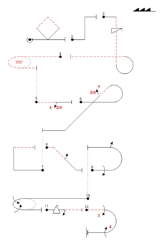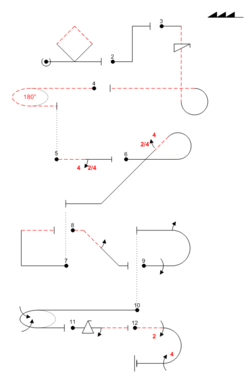
Aresti Catalog
Encyclopedia
 |
|
| An aerobatic sequence in Aresti notation | |
| Family | Contents |
| 1 | horizontal, 45° and vertical lines |
| 2 | turns and rolling turns |
| 3 | combinations of lines – essentially an extension of Family 1 |
| 4 | no longer used; once contained spins, which are now part of Family 9 |
| 5 | hammerheads (stall turns) |
| 6 | tail slides |
| 7 | loops and part loops, curved and angular |
| 8 | combinations of loops and lines |
| 9 | rotational elements: rolls, snap rolls (flicks) and spins |
| Aresti Catalog organization | |
The Aresti Catalog is the Fédération Aéronautique Internationale
Fédération Aéronautique Internationale
The Fédération Aéronautique Internationale is the world governing body for air sports and aeronautics and astronautics world records. Its head office is in Lausanne, Switzerland. This includes man-carrying aerospace vehicles from balloons to spacecraft, and unmanned aerial vehicles...
(FAI) standards document
International standard
International standards are standards developed by international standards organizations. International standards are available for consideration and use, worldwide...
enumerating the aerobatic manoeuvers permitted in aerobatic competition
Competition aerobatics
Competition aerobatics is an air sport in which judges rate the skill of pilots performing aerobatic flying. It is practiced in both piston-powered single-engine airplanes and gliders....
. Designed by Spanish
Spanish people
The Spanish are citizens of the Kingdom of Spain. Within Spain, there are also a number of vigorous nationalisms and regionalisms, reflecting the country's complex history....
aviator
Aviator
An aviator is a person who flies an aircraft. The first recorded use of the term was in 1887, as a variation of 'aviation', from the Latin avis , coined in 1863 by G. de la Landelle in Aviation Ou Navigation Aérienne...
Colonel José Luis Aresti Aguirre (1919–2003), each figure in the catalog is represented by lines, arrows, geometric shapes and numbers representing the precise form of a manoeuver to be flown.
The catalog broadly classifies manoeuvers into numbered families. Families 1 through 8 depict basic figures, such as turns, loops and vertical lines; family 9 depicts rotational elements that can be added to basic figures to increase difficulty, change the direction of flight or invert the g-loading of the aircraft.
Notation
In Aresti notation, solid lines represent upright or positive-g manoeuvers and dashed lines represent inverted or negative-g manoeuvers; these are sometimes depicted in red. Stalled wing manoeuvers such as spinSpin (flight)
In aviation, a spin is an aggravated stall resulting in autorotation about the spin axis wherein the aircraft follows a corkscrew downward path. Spins can be entered intentionally or unintentionally, from any flight attitude and from practically any airspeed—all that is required is sufficient yaw...
s and snap (flick) rolls are represented by triangles.
Arrows represent rolling manoeuvers with numbers representing the extent and number of segments of the roll.
| Symbol | Catalog number |
Component K |
Figure K |
 |
8.40.3 9.11.1.4 9.4.3.4 |
13 5 11 |
29 |
| Notation for a single aerobatic manoeuver comprising a spin, ¾-loop, and 4-point roll | |||
The catalog assigns each manoeuver a unique identifier
Unique identifier
With reference to a given set of objects, a unique identifier is any identifier which is guaranteed to be unique among all identifiers used for those objects and for a specific purpose...
, called a catalog number, and difficulty factor, represented by the symbol K. When a basic figure is combined with one or more rolling elements, the resultant figure K is the sum of all component Ks. During an aerobatics competition, judges grade the execution of each manoeuver with a value between 10 (perfect) and 0 (highly flawed). Each figure's grades are multiplied by its K and summed to yield a total raw score for the flight.
Notational systems for aerobatic manoeuvers have been used since the 1920s.
The first system accepted worldwide was published by French
French people
The French are a nation that share a common French culture and speak the French language as a mother tongue. Historically, the French population are descended from peoples of Celtic, Latin and Germanic origin, and are today a mixture of several ethnic groups...
aviator François d'Huc Dressler in 1955 and 1956. It was used for international competitions through 1962.
José Aresti's development of a notation for aerobatic figures began while serving as an instructor in the Jerez Pilot Training School in the 1940s. By the end of 1961 Aresti published a dictionary of some 3,000 aerobatic manoeuvers, the Sistema Aerocryptographica Aresti. Then employed throughout Spain, the Spanish Aero Club urged its adoption internationally. The FAI's Aerobatics Commission, CIVA, elected to use the catalog beginning at the World Aerobatic Championships held in Bilbao, Spain in 1964; it has been in use worldwide and evolved continually since then. Though the catalog had grown at one time to some 15,000 manoeuvers, a CIVA working group substantially streamlined it in the mid-1980s.
Following Aresti's death, a court fight ensued between his heirs and FAI, which once provided a free catalog online. The catalog is now only available in printed form for a fee from Aresti System S.L.
Software is available to design and display aerobatic sequences using Aresti notation.

